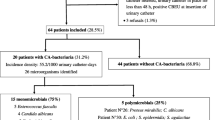Abstract
In a prospective study including 137 consecutive catheterised patients in a medical intensive care unit, the following variables were analysed as possible risk factors for catheter-associated bacteriuria, defined as a quantitative culture with ≥105 organisms/ml: age, sex, simplified acute and physiologic score at admission, duration of catheterisation, diabetes mellitus, immunosuppression, neurologic disorders and prior systemic antibiotic exposure during hospitalisation. The frequency of catheter-associated bacteriuria was 30.7%. By multivariate analysis, female sex (odds ratio [OR], 5.1; 95% confidence interval [CI], 1.9–13.5;P=0.001) and a duration of catheterisation 1 11 days (OR, 19.4; 95% CI, 5.5–68.7;P=0.0001) were risk factors for catheter-associated bacteriuria, and prior antibiotic exposure was a protective factor (OR, 0.06; 95% CI, 0.019–0.21;P=0.0001).
Similar content being viewed by others
Author information
Authors and Affiliations
Rights and permissions
About this article
Cite this article
Tissot, E., Limat, S., Cornette, C. et al. Risk Factors for Catheter-Associated Bacteriuria in a Medical Intensive Care Unit. EJCMID 20, 260–262 (2001). https://doi.org/10.1007/s100960100480
Issue Date:
DOI: https://doi.org/10.1007/s100960100480




